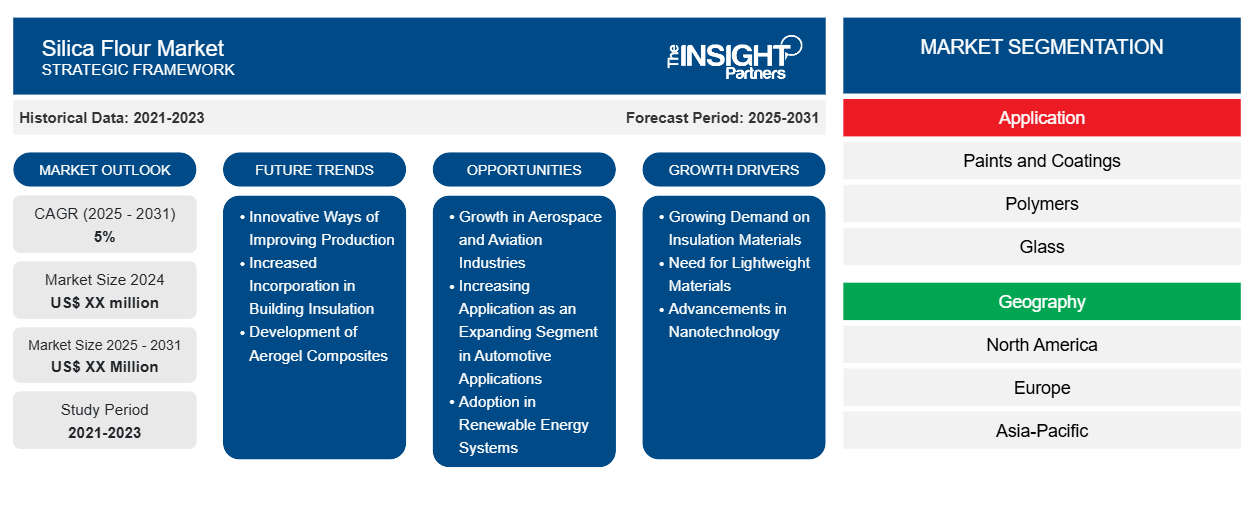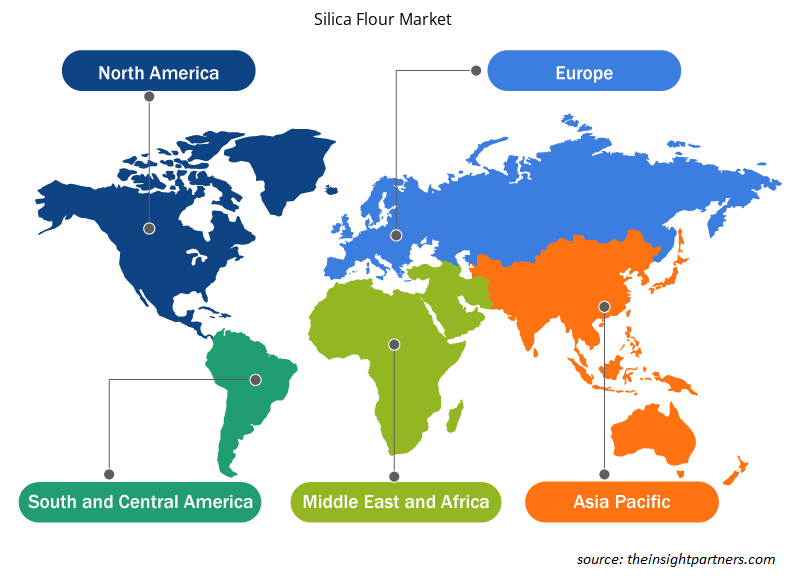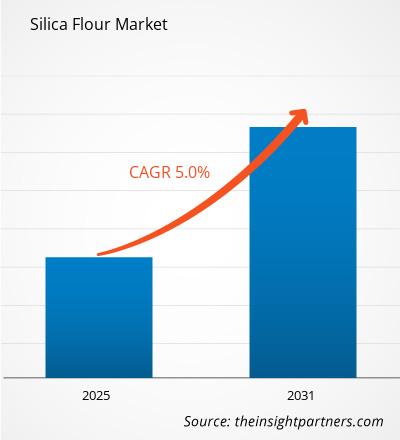The Silica Flour Market is expected to register a CAGR of 5% from 2025 to 2031, with a market size expanding from US$ XX million in 2024 to US$ XX Million by 2031.
Silica Flour Market Size and Forecasts (2021 - 2031), Global and Regional Growth Opportunity Analysis, By Application (Paints and Coatings, Polymers, Glass, Ceramics [Sanitary Ware, Tiles, and Others], By Fused Silica, Countertops, Rubbers, and Others), and Geography (North America, Europe, Asia Pacific, Middle East and Africa, and South and Central America). Silica Flour is a ground form of crystalline silica primarily derivative from high-purity quartz. It is produced by processing and milling silica sand or quartz using techniques. Silica flour is also identified as silica powder or ground silica. Silica flour is characterized by its high silica content and fine particle size.
Purpose of the Report
The report Silica Flour Market by The Insight Partners aims to describe the present landscape and future growth, top driving factors, challenges, and opportunities. This will provide insights to various business stakeholders, such as:
- Technology Providers/Manufacturers: To understand the evolving market dynamics and know the potential growth opportunities, enabling them to make informed strategic decisions.
- Investors: To conduct a comprehensive trend analysis regarding the market growth rate, market financial projections, and opportunities that exist across the value chain.
- Regulatory bodies: To regulate policies and police activities in the market with the aim of minimizing abuse, preserving investor trust and confidence, and upholding the integrity and stability of the market.
Silica Flour Market Segmentation
Application
- Paints and Coatings
- Polymers
- Glass
- Ceramics
- Fused Silica
- Countertops
- Rubbers
You will get customization on any report - free of charge - including parts of this report, or country-level analysis, Excel Data pack, as well as avail great offers and discounts for start-ups & universities
Silica Flour Market: Strategic Insights

- Get Top Key Market Trends of this report.This FREE sample will include data analysis, ranging from market trends to estimates and forecasts.
Silica Flour Market Growth Drivers
- Growing Demand on Insulation Materials: Silica aerogels are emerging as the next thing in ultra-light and highly efficient thermal insulators. As energy-efficient construction becomes popular in fields such as oil and gas as well as the automotive industry, silica aerogels are being introduced to the audience-the demand is growing rapidly. The consuming amounts of energy savings through unique insulation powers offered by silica aerogels are making these materials highly attractive for use in applications globally.
- Need for Lightweight Materials: Due to the primary concern of many industries such as aerospace and automotive, they pay great attention regarding the reduction in weight, which adds to performance along with fuel efficiency; silica aerogles are now among the highly sought-after materials. These materials provide an exclusive feature of dual characteristics i.e., low densities with high strengths which qualify themselves to be part of structural application as insulation panels and protection coatings.
- Advancements in Nanotechnology: They are one of the main early products in nanotechnology and, of course, the advancements in this field lead to increased adoption of silica aerogels. Low cost and scalability will bring silica aerogel production in an economically feasible way to expand the performance by industries in insulation, filtration, and drug delivery. Hence the range increases in application and high demand in the market.
Silica Flour Market Future Trends
- Innovative Ways of Improving Production: Cost-effective production techniques that scale well for silica aerogels are being researched in the process through which they become affordable. Super-critical drying and other advanced synthetic methods are expected to affordably decrease production costs and allow this material to cater to an even wider spectrum of industry applications, including construction, automotive and aerospace.
- Increased Incorporation in Building Insulation: The increased reliance on green building norms and construction practices fuel increased use of silica aerogels in insulation for buildings. Silica aerogels would go a long way in providing high-performance insulation solutions for residential and commercial properties as regulations require improved thermal performance for buildings.
- Development of Aerogel Composites: Silica aerogels will eventually enter composite materials. These silica aerogels could be used to form new materials by mixing them with other materials, such as polymers, carbon fibers, or metals, to create properties like higher strength, lower thermal conductivity, and higher durability, increasing applications by manufacturers.
Silica Flour Market Opportunities
- Growth in Aerospace and Aviation Industries: Silica aerogels are quite effective in aerospace applications for their very low weights as well as insulating properties. On the other hand, the demand for insulation in aircraft, as well as mission spaces that require performance materials with extreme properties, further opens windows for silica aerogels in aerospace applications, more specifically in the area of thermal insulation and structural composites.
- Increasing Application as an Expanding Segment in Automotive Applications: Silica aerogels can leave their footprints on the automotive industry by introducing the technology of manufacturing even lighter cars, which promises to become a significant opportunity. This anticipated addition could help manufacturers save weight and increase thermal efficiency to conserve fuel while boosting performance-including that for higher-energy consuming electric and hybrid vehicles-in such as by inclusion in insulation and structural elements of vehicles.
- Adoption in Renewable Energy Systems: Silica aerogels will indeed play an important part in improving solar-thermal systems and wind energy applications-all at that juncture that the world switches to a green energy course. Their insulating properties would keep temperature optimums for operation in both solar collectors and turbines, thereby creating additional avenues of availability in renewables.
Silica Flour Market Regional Insights
The regional trends and factors influencing the Silica Flour Market throughout the forecast period have been thoroughly explained by the analysts at Insight Partners. This section also discusses Silica Flour Market segments and geography across North America, Europe, Asia Pacific, Middle East and Africa, and South and Central America.

- Get the Regional Specific Data for Silica Flour Market
Silica Flour Market Report Scope
| Report Attribute | Details |
|---|---|
| Market size in 2024 | US$ XX million |
| Market Size by 2031 | US$ XX Million |
| Global CAGR (2025 - 2031) | 5% |
| Historical Data | 2021-2023 |
| Forecast period | 2025-2031 |
| Segments Covered |
By Application
|
| Regions and Countries Covered | North America
|
| Market leaders and key company profiles |
Silica Flour Market Players Density: Understanding Its Impact on Business Dynamics
The Silica Flour Market is growing rapidly, driven by increasing end-user demand due to factors such as evolving consumer preferences, technological advancements, and greater awareness of the product's benefits. As demand rises, businesses are expanding their offerings, innovating to meet consumer needs, and capitalizing on emerging trends, which further fuels market growth.
Market players density refers to the distribution of firms or companies operating within a particular market or industry. It indicates how many competitors (market players) are present in a given market space relative to its size or total market value.
Major Companies operating in the Silica Flour Market are:
- Adinath Industries
- Adwan Chemical Industries Company
- AGSCO Corporation
- BMS Factories
- Cairo Fresh for Minerals and Quarries Materials
Disclaimer: The companies listed above are not ranked in any particular order.

- Get the Silica Flour Market top key players overview
Key Selling Points
- Comprehensive Coverage: The report comprehensively covers the analysis of products, services, types, and end users of the Silica Flour Market, providing a holistic landscape.
- Expert Analysis: The report is compiled based on the in-depth understanding of industry experts and analysts.
- Up-to-date Information: The report assures business relevance due to its coverage of recent information and data trends.
- Customization Options: This report can be customized to cater to specific client requirements and suit the business strategies aptly.
The research report on the Silica Flour Market can, therefore, help spearhead the trail of decoding and understanding the industry scenario and growth prospects. Although there can be a few valid concerns, the overall benefits of this report tend to outweigh the disadvantages.
Frequently Asked Questions
What are the future trends in the market?
Growing demand for sustainable construction materials is an emerging trend in the market.
Which application segment accounted for the highest share in the silica flour market?
The paints and coatings segment accounted for the largest market share in 2023
Based on geography, which region is expected to record a highest CAGR in the market.
The North America market is expected to account for the highest CAGR during the forecast period, owing to the growing glass manufacturing in the region.
What are the driving factors impacting the silica flour market market?
Increasing glass manufacturing is a key driver in the market.
What are the key players operating in the silica flour market market?
AGSCO Corporation, Adwan Chemical Industries Co. Ltd, Delmon Group of Companies, Hoben International Limited, Opta Minerals Inc., SCR-Sibelco NV, Sil industrial minerals, PolyOne Corporation, Sanitized AG, and BioCote Limited are some of the key players in the market.
What is the expected CAGR of the Silica Flour Market ?
The Silica Flour Market is estimated to witness a CAGR of 5% from 2023 to 2031
- Historical Analysis (2 Years), Base Year, Forecast (7 Years) with CAGR
- PEST and SWOT Analysis
- Market Size Value / Volume - Global, Regional, Country
- Industry and Competitive Landscape
- Excel Dataset
Testimonials
I wish to appreciate your support and the professionalism you displayed in the course of attending to my request for information regarding to infectious disease IVD market in Nigeria. I appreciate your patience, your guidance, and the fact that you were willing to offer a discount, which eventually made it possible for us to close a deal. I look forward to engaging The Insight Partners in the future, all thanks to the impression you have created in me as a result of this first encounter.
DR CHIJIOKE ONYIA, MANAGING DIRECTOR, PineCrest Healthcare Ltd.The Insight Partners delivered insightful, well-structured market research with strong domain expertise. Their team was professional and responsive throughout. The user-friendly website made accessing industry reports seamless. We highly recommend them for reliable, high-quality research services
Yukihiko Adachi CEO, Deep Blue, LLC.Reason to Buy
- Informed Decision-Making
- Understanding Market Dynamics
- Competitive Analysis
- Customer Insights
- Market Forecasts
- Risk Mitigation
- Strategic Planning
- Investment Justification
- Identifying Emerging Markets
- Enhancing Marketing Strategies
- Boosting Operational Efficiency
- Tracking Industry Innovations
- Aligning with Regulatory Trends
Yes! We provide a free sample of the report, which includes Report Scope (Table of Contents), report structure, and selected insights to help you assess the value of the full report. Please click on the "Download Sample" button or contact us to receive your copy.
Absolutely — analyst assistance is part of the package. You can connect with our analyst post-purchase to clarify report insights, methodology or discuss how the findings apply to your business needs.
Once your order is successfully placed, you will receive a confirmation email along with your invoice.
• For published reports: You’ll receive access to the report within 4–6 working hours via a secured email sent to your email.
• For upcoming reports: Your order will be recorded as a pre-booking. Our team will share the estimated release date and keep you informed of any updates. As soon as the report is published, it will be delivered to your registered email.
We offer customization options to align the report with your specific objectives. Whether you need deeper insights into a particular region, industry segment, competitor analysis, or data cut, our research team can tailor the report accordingly. Please share your requirements with us, and we’ll be happy to provide a customized proposal or scope.
The report is available in either PDF format or as an Excel dataset, depending on the license you choose.
The PDF version provides the full analysis and visuals in a ready-to-read format. The Excel dataset includes all underlying data tables for easy manipulation and further analysis.
Please review the license options at checkout or contact us to confirm which formats are included with your purchase.
Our payment process is fully secure and PCI-DSS compliant.
We use trusted and encrypted payment gateways to ensure that all transactions are protected with industry-standard SSL encryption. Your payment details are never stored on our servers and are handled securely by certified third-party processors.
You can make your purchase with confidence, knowing your personal and financial information is safe with us.
Yes, we do offer special pricing for bulk purchases.
If you're interested in purchasing multiple reports, we’re happy to provide a customized bundle offer or volume-based discount tailored to your needs. Please contact our sales team with the list of reports you’re considering, and we’ll share a personalized quote.
Yes, absolutely.
Our team is available to help you make an informed decision. Whether you have questions about the report’s scope, methodology, customization options, or which license suits you best, we’re here to assist. Please reach out to us at sales@theinsightpartners.com, and one of our representatives will get in touch promptly.
Yes, a billing invoice will be automatically generated and sent to your registered email upon successful completion of your purchase.
If you need the invoice in a specific format or require additional details (such as company name, GST, or VAT information), feel free to contact us, and we’ll be happy to assist.
Yes, certainly.
If you encounter any difficulties accessing or receiving your report, our support team is ready to assist you. Simply reach out to us via email or live chat with your order information, and we’ll ensure the issue is resolved quickly so you can access your report without interruption.















The List of Companies
1.Adinath Industries
2.Adwan Chemical Industries Company
3.AGSCO Corporation
4.BMS Factories
5.Cairo Fresh for Minerals and Quarries Materials
6.Elkem AS
7.Fineton Development Limited
8.Green Egypt Group
9.Gulf Minerals and Chemicals LLC
10.Hoben International Limited
11.Knouz,
12.Quarzwerke GmbH
13.RP Enterprise
14.SAC Corporation
15.Saudi Arabian Oil Co.
16.Sibelco Group
17.Sil Industrial Minerals
18.Suez Company for Minerals
19.Tasmanian Advanced Minerals
20.Terengganu Silica Consortium Sdn. Bhd.






 Get Free Sample For
Get Free Sample For